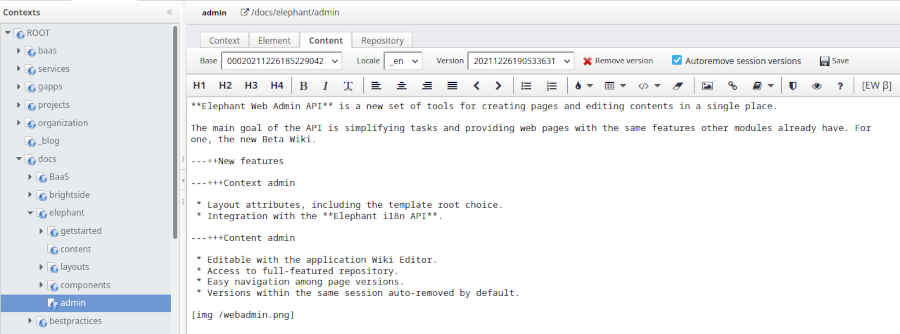| Alliance.Client.Grants.ReadServers |
Disables server-reading Project Grants when false |
true |
| Appearance.Color.Primary |
Primary color, should be set to stylesheet primary color, can be used in Wmacros with color, as primary |
|
| Appearance.Color.Secondary |
Secondary color, should be set to stylesheet secondary color, can be used in Wmacros with color, as secondary |
|
| Appearance.Color.C1 |
Free definition, can be used in Wmacros with color, as c1 |
|
| Appearance.Color.C2 |
Free definition, can be used in Wmacros with color, as c2 |
|
| Appearance.Color.C3 |
Free definition, can be used in Wmacros with color, as c3 |
|
| Authentication.AllowCenters |
Disables centers from authenticate when false |
false |
| Authentication.AllowCompanies |
Disables companies from authenticate when false |
false |
| Authentication.AllowLiveLinks |
Disables LiveLinks when false |
true |
| Contact.Relation.Professional.Autovalidate |
Professional relations will auto-validate when true |
false |
| Contact.Relation.Student.Autovalidate |
Student relations will auto-validate when true |
false |
| Context.Mobile.Path |
When defined, enables a different landing for mobile devices |
|
| Directory.Networking.Access.BasicRoles |
Basic roles for accessing directories |
@admin:is|@patron:on|@partner:on |
| Directory.Networking.Access.PremiumRoles |
Premium roles for accessing premium features |
@admin:is|@patron:on|@partner:on |
| Directory.Networking.Centers.ListedRoles |
Center's roles in order to be listed |
@center:is |
| Directory.Networking.Companies.ListedRoles |
Company's roles in order to be listed |
@company:is |
| Directory.Networking.Entities.ListedRoles |
Company or Center roles in order to be listed |
@company:is|@center:is |
| Directory.Networking.ListedRoles |
Contact's roles in order to be listed |
@natural:is|@responsible:is |
| Directory.Networking.Professionals.ListedRoles |
Contact's roles in order to be listed |
@worker:is|@responsible:is |
| Dossier.View.DaysToBeNew |
Maximum days passed since created or changed phase, to be considered new |
30 |
| Profile.Documents.Maximum |
Defines the maximum public documents per profile |
3 |
| Profile.Suggest.Company |
Suggests improving company or center description |
false |
| Profile.Suggest.Image |
Suggests users to add the avatar to the profile |
false |
| Profile.Suggest.Professional.Documents |
Suggests adding public documents to professional's profile |
false |
| Profile.Suggest.Relation |
Strongly suggests users to add a relation |
false |
| Profile.Suggest.Skills |
Suggests users to add skills |
false |
| Profile.Suggest.Student.Documents |
Suggests adding public documents to student's profile |
true |
| Service.New.AllowRoles |
Contact's roles to be able to publish |
@partner:on |
| Service.New.AllowSingle |
Allows unrelated contacts to publish |
false |
| Service.Question.AllowRoles |
Contact's roles to be able send questions |
@partner:on|@patron:on |
| Service.Recipients.Roles |
Contact's roles that will receive notifications |
@admin:is|@partner:on|@patron:on|@guest:on |
| SignUp.Allow |
Disables creating new accounts when false |
true |
| SignUp.AllowRelations |
Enables creating a relation for new accounts when true |
false |
| SignUp.Default.SocialGroup |
Sets de default social group for new accounts |
guest |
| SignUp.TellSomeone.Allow |
Disables the 'Tell someone' feature when false |
true |
| Site.Name |
Sets de site name |
|
| Site.Domain |
Forces the site to work with this domain. Important when using SSL. |
|
| Site.Description |
Sets site description. |
|
| Site.Keywords |
Sets site keywords. |
|
| Site.Fonts |
Loads fonts from G-Fonts. |
Lato |
| Site.Icon |
Icon absolute URL. |
|
| Site.Locales |
Sets site locales, usually the same as in ROOT context. |
|
| Site.Files |
Site internal files. |
|
| Site.Encoding |
Site encoding. |
ISO-8859-1 |
| Site.TemplatesRoot |
Templates root. |
templates-semantic |
| Site.UseSSL |
Use SSL (requires certificate) |
false |
